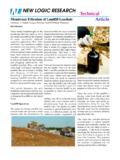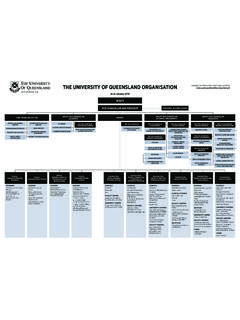Transcription of Review on Research for Removal of Phenol from …
1 International Journal of Scientific and Research Publications, Volume 3, Issue 4, April 2013 1 ISSN 2250-3153 Review on Research for Removal of Phenol from Wastewater Sunil J. Kulkarni*, P. Kaware** *Chemical Engineering Department, Datta Meghe College of Engineering, Airoli, Navi Mumbai ** Chemical Engineering Department, College of Engineering and Technology, Akola Abstract - Phenol is a major pollutant in the wastewater because of its presence in the effluent of major processing and refining plants. It has severe effect on human being, both short term and long term.
2 Various methods are used for Removal of the Phenol from wastewater such as adsorption, photodecomposition, volatilization and other various biological and non-biological methods. In the present study attempt is done to present the survey of the Research on the Phenol Removal by various methods. The methods such as Polymerization, electrocoagulation, extraction, photodecomposition, advanced oxidation and ion exchange were used effectively by various investigators. These methods are reported to be efficient for the Phenol Removal .
3 Suitable method for Phenol Removal can be selected based on availability of the material, extent of separation required and properties of phenolic effluent. Index Terms - Phenol , effluent, concentration, enzyme, adsorbent I. INTRODUCTION eveloping green and sustainable technology for the effluent treatment is very important Research area in this era of industrial and social development. Many researchers have carried out the Research in this field. One of the important pollutants from this point of view is Phenol .
4 It has its presence in the effluent from major chemical and pharmaceutical industries such as petrochemical industries, petroleum refineries, coal gasification operations, liquefaction process, resin manufacturing industries, dye synthesis units, pulp and paper mills and pharmaceutical industries. It is a highly corrosive and nerve poisoning agent. Phenol causes harmful side effects such as sour mouth, diarrhea, impaired vision, excretion of dark urine. It is also toxic for fishes. The toxic levels usually range between the concentrations of 10-24 mg/L for human and the toxicity level for fish between 9-25 mg/l.
5 Lethal blood concentration of Phenol is around 150-mg/100 ml. Various treatment processes used for the Removal and/or recovery of phenols are hot gas or steam stripping, adsorption, ion exchange solvent extraction, oxidation, phase transfer catalysis and biological treatment processes. Phenolic waste water is treated using activated carbon in the fixed bed/ moving bed/ fluidized bed. II. VARIOUS METHODS FOR Phenol Removal Stanisavljevi and Nedi have carried out a Research on Phenol Removal by polymerization.
6 They carried out the Phenol Removal in a reaction step which was polymerization of Phenol in presence of an enzyme horseradish peroxidise (HRP)[1]. They used hydrogen peroxide along with the peroxidase enzyme. The native enzyme (E) is oxidized by peroxide (H2O2) to an active intermediate enzymatic form . This accepts an aromatic compound into its active site and carries out its oxidation. A free radical is produced and released into solution leaving the enzyme in the compound state. This compound oxidizes a second aromatic molecule, releasing another free radical product and returning the enzyme to its native state, thereby completing the cycle.
7 The Free radicals formed during the cycle diffuse from the enzyme into the bulk solution where they react to form polyaromatic products. These polymers are water-insoluble and may be removed by solid liquid operations. It was observed that Phenol conversion in all experimented conditions was greater than 90%. The high efficiency observed is in accordance with conditions optimized to guarantee 90% polymerization using purified HRP. There is a compromise between the reduction in variable costs by the use of fewer enzymes and the increase in capital investment at the time of building the treatment facility.
8 The effect of horseradish peroxidase (HRP) and H2O2 concentrations on the Removal efficiency of Phenol , defined as the percentage of Phenol removed from solution as a function of time, has been investigated by Vasudevan and Li[2]. They found that the Phenol is almost completely precipitated within 10 minutes.. The Removal efficiency increases with an increase in the concentration of HRP, but an increase in the time of treatment cannot be used to offset the reduction in Removal efficiency at low concentrations of the enzyme, because of inactivation of the enzyme.
9 Nicell et. al. have carried out the search on Phenol polymerization and precipitation using polyethylene glycol as additive [3]. They observed that the presence of polyethylene glycol enhance enzyme performance for the treatment of synthetic wastewaters containing a range of Phenol concentrations between 0 5 and 16 millimolar (47 to 1500 mg/l) at neutral pH. Results demonstrated a significant improvement in catalyst lifetime in the presence polyethylene glycol in both batch and continuous stirred tank reactor configurations.
10 Free and immobilized horseradish peroxidase was used for Phenol polymerization by Pradip et. al. [4]. They used Horse Radish roots for the extraction of peroxidase enzyme in the laboratory. Buffer of pH was used to soak the roots in order to avoid the enzyme inactivation during crushing and extraction. They observed that Phenol polymerization of 84% was achieved at 100 mg/l using free HRP enzyme and Phenol degradation of 62% was observed using Immobilized HRP enzyme bed reactor.















